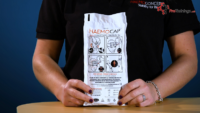Imagine you are a first aider. You will know that most lacerations will stop bleeding when applying pressure. But what if you have to continue to press on the wound for several minutes? This would waste precious time! Haemocap Multisite is a unique, patented, compression device useful for traumatic bleeding wounds. Instead of using traditional bandages, you can use the Haemocap instead. It is a non-sterile, disposable, safe device that is usable in an ultra-fast fashion. This enables the first aider to attend other wounds or casualties. It is not a tourniquet or a vascular clamp, but simply provides adequate compression to the wound to aid natural haemostasis but could also be used in addition to any topical haemostats that are available.
We recommend to use a sterile gauze as well as the Haemocap. Once secured, you evacuate the air from the device using any vacuum producing equipment such as a pump, aspirator or portable suction. You cannot exert any more pressure once you have removed all of the air. The device is reusable on the same patient, can be de-vacced and removed easily and quickly to inspect the wound. Once you have reached haemostasis, you remove the device and disposes of it in a clinical waste bin. Haemocap generates approximately 50 millimetres of pressure to the wound depending on the initial application. We have produced the above film to show how to put it on correctly.
Another Example of the Haemocap
Here is another example like the video above:
“Tilly has had a head injury which is bleeding. I have taken some sterile gauze, I place it on the Haemocap device and put it directly over the wound. With a hook and loop material, it goes below the ears and it is firmly attached. I can then tear off any excess material, meaning it will not be in the way later on. I then take a suction device, insert it to the port and evacuate the air. Once all the air is evacuated, no more pressure can be exerted. I can then close the clip and easily remove the suction device. The Haemocap is stable, should be comfortable exerting pressure enough for haemostasis. If I want to re-inspect the wound, I will take the vacuum off. Then I will take the Haemocap device out, inspect the wound and if necessary reapply it.
Once you have applied the Haemocap device, you can tear any excess loop material. For a neck wound, Haemocap again is placed directly over the wound and the hook and loop material is wound under the arm. Again, I firmly attached it at the back. You can connect the suction device, evacuate the air and achieve compression. For a thigh wound, you can place a sterile gauze underneath the Haemocap device. Then you place it directly over the wound and firmly strap with a hook and loop. Finally, you can evacuate the air again and reapply any pressure. This, as before, helps a lot to stop the bleeding.”
For more information on training courses, visit our “Courses” page which also includes our First Responder and First Person on Scene (FPOS) Courses.


